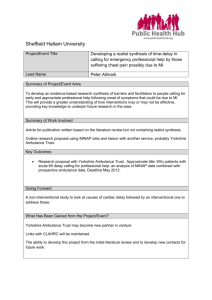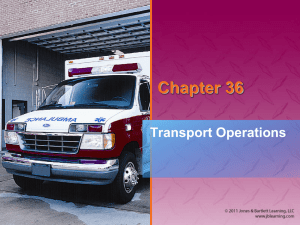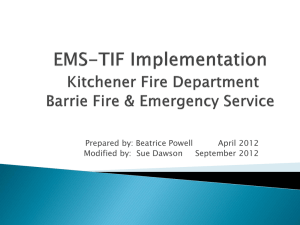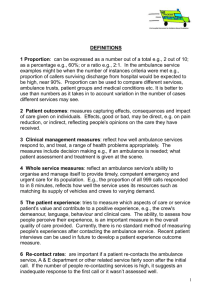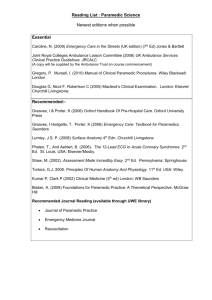Emergency Services Planning Proposal
advertisement
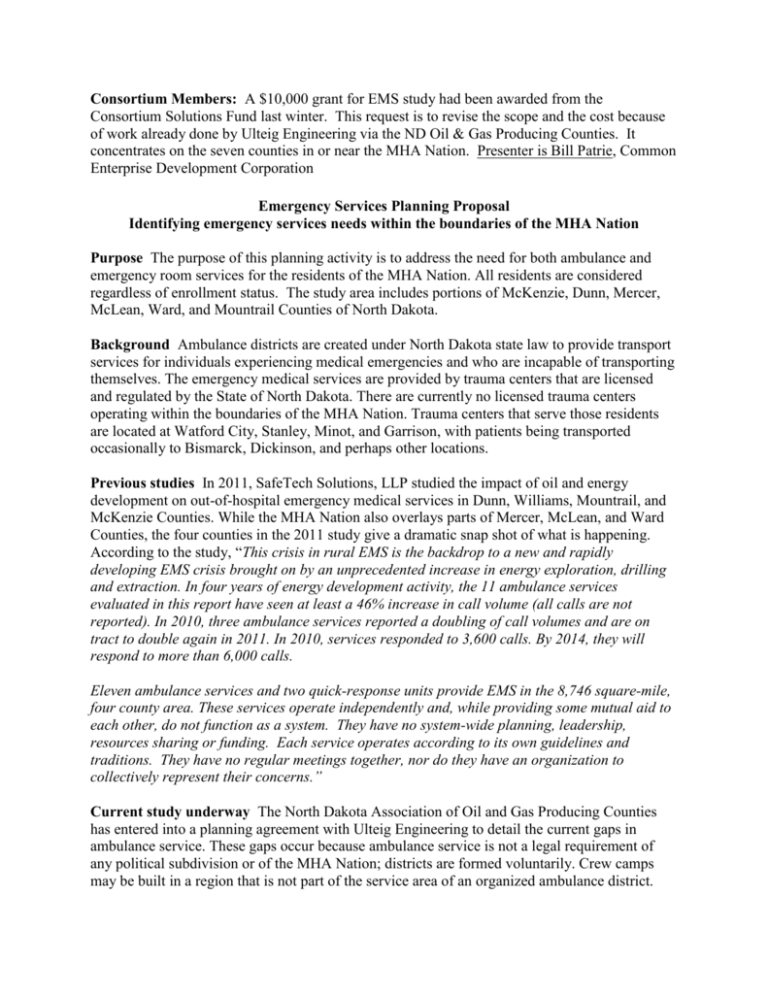
Consortium Members: A $10,000 grant for EMS study had been awarded from the Consortium Solutions Fund last winter. This request is to revise the scope and the cost because of work already done by Ulteig Engineering via the ND Oil & Gas Producing Counties. It concentrates on the seven counties in or near the MHA Nation. Presenter is Bill Patrie, Common Enterprise Development Corporation Emergency Services Planning Proposal Identifying emergency services needs within the boundaries of the MHA Nation Purpose The purpose of this planning activity is to address the need for both ambulance and emergency room services for the residents of the MHA Nation. All residents are considered regardless of enrollment status. The study area includes portions of McKenzie, Dunn, Mercer, McLean, Ward, and Mountrail Counties of North Dakota. Background Ambulance districts are created under North Dakota state law to provide transport services for individuals experiencing medical emergencies and who are incapable of transporting themselves. The emergency medical services are provided by trauma centers that are licensed and regulated by the State of North Dakota. There are currently no licensed trauma centers operating within the boundaries of the MHA Nation. Trauma centers that serve those residents are located at Watford City, Stanley, Minot, and Garrison, with patients being transported occasionally to Bismarck, Dickinson, and perhaps other locations. Previous studies In 2011, SafeTech Solutions, LLP studied the impact of oil and energy development on out-of-hospital emergency medical services in Dunn, Williams, Mountrail, and McKenzie Counties. While the MHA Nation also overlays parts of Mercer, McLean, and Ward Counties, the four counties in the 2011 study give a dramatic snap shot of what is happening. According to the study, “This crisis in rural EMS is the backdrop to a new and rapidly developing EMS crisis brought on by an unprecedented increase in energy exploration, drilling and extraction. In four years of energy development activity, the 11 ambulance services evaluated in this report have seen at least a 46% increase in call volume (all calls are not reported). In 2010, three ambulance services reported a doubling of call volumes and are on tract to double again in 2011. In 2010, services responded to 3,600 calls. By 2014, they will respond to more than 6,000 calls. Eleven ambulance services and two quick-response units provide EMS in the 8,746 square-mile, four county area. These services operate independently and, while providing some mutual aid to each other, do not function as a system. They have no system-wide planning, leadership, resources sharing or funding. Each service operates according to its own guidelines and traditions. They have no regular meetings together, nor do they have an organization to collectively represent their concerns.” Current study underway The North Dakota Association of Oil and Gas Producing Counties has entered into a planning agreement with Ulteig Engineering to detail the current gaps in ambulance service. These gaps occur because ambulance service is not a legal requirement of any political subdivision or of the MHA Nation; districts are formed voluntarily. Crew camps may be built in a region that is not part of the service area of an organized ambulance district. While neighboring ambulance districts are very good about providing mutual aid, as the SafeTech Solutions study pointed out, there are cases where no ambulance was able to answer a 911 call. Responders were simply not available. Not only have ambulance districts experienced rapid growth in the number of calls, the emergency rooms have been stressed as well. It has been reported that Minot Trinity Hospital emergency room has experienced as many visits as the Sanford and St. Alexius Hospitals in Bismarck combined. If emergency services are not available locally, an ambulance run from Mountrail County to Bismarck can take an ambulance out of service for the entire day. Interest in a new trauma center The MHA Nation has commissioned a Bismarck design firm to create preliminary plans for the construction of an “urgent care” facility to be built at the Elbowoods Memorial Health Center complex on the North East side of New Town. Planning is currently under way to develop a highway by-pass around the city of New Town. This by-pass may provide more rapid access to an urgent care facility, especially for ambulances coming across the Four Bears bridge, which now navigates heavy traffic through the heart of New Town. Integrated care Currently the MHA Nation operates the Elbowoods Memorial Health Center and satellite clinics at Parshall, White Shield, Twin Buttes, and Mandaree under a contract with the Indian Health Service. A study is underway to determine the advisability of operating those facilities as federally qualified health centers (FQHC), allowing the facilities to serve all patients, not just those eligible for Indian Health Service benefits. In the State of Alaska, FQHC facilities serve Indian Health Service eligible patients and those eligible for Veterans benefits, as well as the general public and the un-insured. Operating an urgent care facility and an after-hours clinic in New Town may take pressure off surrounding emergency care facilities who can be called into providing routine medical care simply because there are no clinics open. UND Healthcare needs assessment underway The MHA Nation has contracted with Common Enterprise Development Corporation to complete a healthcare assessment, which will be used to determine the advisability of converting the existing tribally operated healthcare system to the FQHC model. CEDC has contracted with the Social Science Research Institute at the University of North Dakota to conduct a phone survey to complete this assessment. A random sample of all residents within the MHA Nation boundaries will generate about 500 phone interviews covering 16 healthcare questions. CEDC has added emergency services questions to this survey, and consequently, will have a snap shot of emergency service usage identified by communities. This survey will provide an idea of past services provided and by which ambulance district, as well as the facility to which the patient was then transported. What else do we need to know? 1. Non-emergency visits: The UND study will provide an estimate of the number of emergency room visits by residents within the MHA Nation boundaries were for routine care rather than true emergencies. This number, however, will be a projection rather than actual. Further research will provide a closer estimate by looking at Indian Health Service claims that were denied because they were deemed non-emergency. By knowing the zip code of the patient and the service provider, we can identify the volume and cost of non- 2. 3. 4. 5. 6. emergency care being provided by trauma centers. A method of determining nonemergency care by residents who do not qualify for Indian Health Service reimbursement needs to be developed. This study will also determine the amount of unreimbursed claims for the treating facility and the ambulance district, again by segment. Unreimbursed claims will be broken into categories of reasons the payment was not made, again with the goal to improve reimbursement rates to the emergency service providers and to the ambulance districts. Which existing ambulance districts are serving which segments of the MHA Nation: It is expected that Twin Buttes residents may be going to Dickinson, White Shield to Garrison, and Parshall to Minot, but that may not be true. This study will determine if ambulance districts are transporting patients past the nearest emergency room, to a more distant facility; why this is occurring; and what, if anything, can be done to reduce travel time and/or improve local care. This study will also identify ways to improve air transport by shortening transport times and reducing costs. This study will identify ways ambulance districts might cooperate to more effectively recruit and train volunteers and employ professional emergency medical services personnel. It will also identify ways to share and more fully utilize equipment. This study will identify opportunities to extend the service areas of existing districts, build new facilities (i.e. Mandaree), and form cooperative agreements for operations. This is a short-term study only, designed to fill the gaps in ambulance and emergency room services identified in the Ulteig study and discovered through antidotal evidence. It will be actionable upon its completion. Research methodology Common Enterprise Development Corporation will design data collection, analysis, and recommendations for actions that are based on in-person interviews with emergency room administrators and ambulance districts. An advisory committee will be formed to insure that the data collected is readily available, easy to retrieve, and protects confidentiality, as well as to insure that the outcomes of the research are useful to the participating service providers. Tasks Selecting and recruiting the advisory committee Designing the survey instruments and interview questions Conducting the surveys/interview Compiling the data and preparing graphics Hosting a design summit to propose action steps Drafting, printing, and publishing final report Hosting an implementation meeting Mileage (2,838 miles at .555) and meals ($300) Total Hours 25 30 130 60 30 60 24 Expenses 1,875 359 Total Costs 1,750 1,750 7,375 3,500 1,750 3,750 1,400 1,875 $23,150
